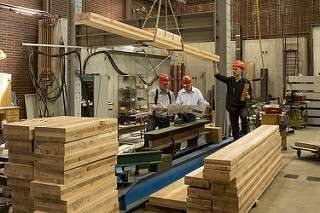Researcher studies cross-laminated timber as seismic retrofit tool

Safer historic buildings and more jobs for the timber industry are the goals of a partnership between an Oregon State University structural engineering researcher and a newly formed nonprofit group in Corvallis, Oregon.
Andre Barbosa of the OSU College of Engineering is collaborating with Cascadia Seismic Strategies on a $150,000 project to study the use of cross-laminated timber panels for seismic retrofits on unreinforced masonry buildings.
A grant coordinated through the Downtown Corvallis Association and Oregon Main Street is covering roughly two-thirds of the cost of the project, which will result in mockups of CLT retrofit systems at the 107-year-old Harding Building at Third Street and Madison Street in Corvallis.
"We'll build prototypes that will provide details that will let engineers and construction folks see how things go together," said Barbosa, a volunteer with Cascadia Seismic Strategies.
Barbosa is one of the original members of the group, named after the subduction zone that lies off the coast of Oregon. The major Cascadia earthquake that experts say is on the horizon would be particularly damaging to vintage masonry structures like the Harding Building, the cornerstone of the original Third Street business district.
"The DCA is concerned about the potential devastation that a Cascadia Subduction Zone mega-quake would wreak," said Cascadia Seismic Strategies spokeswoman Roz Keeney. "Members of the DCA's design committee recruited structural engineers, historic architects and other building professionals to join in a conversation about earthquake preparedness and historic building preservation. This group went on to form Cascadia Seismic Strategies, which is now focused on this cutting-edge project to develop a low-cost reinforcement method using local wood products and off-the-shelf steel connectors."
Engineering work is scheduled to start in August. The grant for the 34-month project underwrites multiple design and construction strategies for dealing with weaknesses in unreinforced masonry buildings, as well as production of a video demonstrating how to implement upgrades that can serve as a guide for other communities wanting to use similar strategies in preservation and retrofitting efforts.
"This project identifies seismic retrofits for historic buildings that improve their safety performance without compromising their historic integrity," said project manager and historic preservation architect Sue Licht. "It also demonstrates that historic rehabilitation can create local, site-specific jobs that cannot be outsourced."
Barbosa notes that OSU is a leader in developing new wood products such as cross-laminated timber and in growing forest-products jobs amid reduced harvest levels.
"It's important to bring jobs back to the timber industry in Oregon and to find new applications for mass timber," he said. "This could potentially be one of them, while improving the resiliency of downtowns and the older buildings that give us liveliness and history."
Portland firm KPFF Consulting Engineers will handle most of the structural engineering, led by Reid Zimmerman, with Barbosa lending his expertise in cross-laminated timber and seismic retrofits.
"This comes from what we've been learning by visiting different earthquake sites, like Napa (California) and Nepal," Barbosa said. "We keep learning and try to bring back that knowledge and share it with communities, including by creating a model for affordable seismic retrofits for historic buildings. This is a grass-roots, community-driven solution for a big problem, a huge Cascadia quake."
The primary funding organization, Oregon Main Street, is a Main Street America coordinating program administered by the State Historic Preservation Office. It works with Oregon communities to "develop comprehensive, incremental revitalization strategies based on a community's unique assets, character and heritage."
Its goal is to build "high-quality, livable and sustainable communities that will grow Oregon's economy while maintaining a sense of place."
Provided by Oregon State University


















